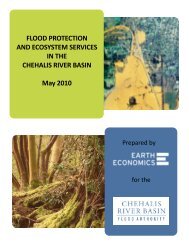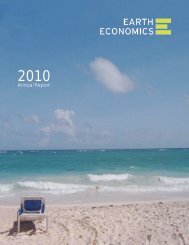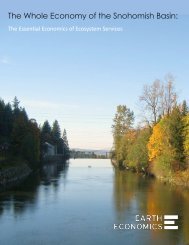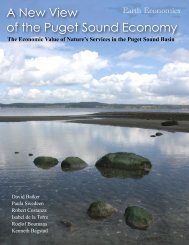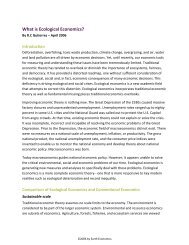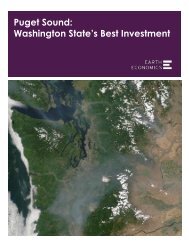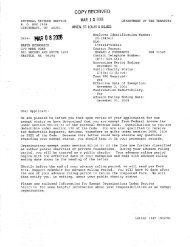The Spot Prawn Fishery: A Status Report - Earth Economics
The Spot Prawn Fishery: A Status Report - Earth Economics
The Spot Prawn Fishery: A Status Report - Earth Economics
You also want an ePaper? Increase the reach of your titles
YUMPU automatically turns print PDFs into web optimized ePapers that Google loves.
<strong>The</strong> <strong>Spot</strong> <strong>Prawn</strong> <strong>Fishery</strong>: A <strong>Status</strong> <strong>Report</strong><br />
“rot away” cord in pot gear; 2) a limited trawl season<br />
of April 1 through October 31; 3) keeping<br />
and submission of logbooks to WDFW.<br />
<strong>The</strong> bulk of the fishery takes place an average of<br />
25–30 miles offshore, and to date there has been<br />
no Tribal participation in the fishery. In 1992,<br />
approximately 2,480 pounds of spot prawns<br />
were landed off Westport in the Grays Canyon<br />
area. In 1993, four pot vessels actively targeted<br />
spot prawns and caught a total of 13,555 pounds.<br />
An Oregon-based trawler entered the fishery in<br />
1994 and harvested approximately two-thirds of<br />
the annual catch limit of 65,854 pounds. No landings<br />
were recorded in 1995. <strong>The</strong> WDFW believes<br />
that this is because fishers pursued more lucrative<br />
opportunities, particularly for albacore. In 1996,<br />
four pot boats re-entered the fishery and landed<br />
22,389 pounds of spot prawns. In addition, approximately<br />
130 pounds of spot prawns were reported<br />
as incidental trawl catch.<br />
<strong>The</strong> offshore fishery changed dramatically in<br />
1997, when five trawl boats entered the fishery<br />
and landed 112,284 pounds of spot prawns,<br />
approximately 84% of the total offshore catch.<br />
WDFW believes that this increase in trawl<br />
involvement was in part driven by a dramatic<br />
increase in demand for spot prawns, especially<br />
for the live market. <strong>The</strong> WDFW expressed concern<br />
about the dramatic increase in fishing<br />
effort evidenced in this 1997 season. Interest in<br />
the fishery was growing. In addition, the potential<br />
for rapid expansion was great, due to significant<br />
reductions in groundfish quotas and below-average<br />
catches of other important fisheries, such as<br />
pink shrimp.<br />
<strong>The</strong>se management concerns and limited knowledge<br />
about the “distribution, abundance, and<br />
sustainability of the resource” (WDFW 2001c) led<br />
WDFW to recommend that the provisions of the<br />
Emerging Commercial Fisheries Act (ECFA) be<br />
applied to the coastal spot prawn fishery. <strong>The</strong><br />
Northwest Indian Fisheries Commission Member Tribes<br />
Map Courtesy Northwest Indian Fisheries Commission<br />
28



